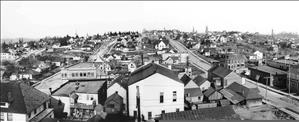Rainier Valley en Seattle es a la vez un vecindario y una característica geográfica. El valle, que no es un curso de agua sino el terreno bajo entre dos colinas, se extiende unas siete millas hacia el sudeste desde el centro de Seattle hasta el Lago Washington. Como vecindario, "Rainier Valley" se refiere más frecuentemente a las porciones norte y central del valle, pero el nombre se usa a veces para toda la longitud del valle, incluyendo vecindarios tales como Columbia City y Rainier Beach. Los residentes Salish de la costa tenían un sendero bien definido a través del valle y varias viviendas comunales permanentes construidas de madera de cedro en la costa del lago. Los primeros colonizadores no indígenas llegaron en la década de 1850, pero la colonización fue lenta hasta que las grandes zonas boscosas fueron cortadas y procesadas en los aserraderos locales. El Ferrocarril Eléctrico Rainier Avenue, construido a lo largo del trayecto actual de Rainier Avenue S, abrió el valle al desarrollo suburbano y eventualmente urbano. La línea férrea alcanzó Columbia City en 1891 y Renton en 1896, y fue una conexión fundamental hasta que dejó de funcionar en 1937. Rainier Valley ha sido por mucho tiempo el hogar de muchos inmigrantes, con predominio de Ítalo-americanos y Japoneses Americanos antes de la Segunda Guerra Mundial (que trajo el internamiento de los ciudadanos Americanos de origen japonés). Tiempos de prosperidad durante y después de la guerra trajeron muchos más residentes. Se mudaron allí Afroamericanos de otros estados y de la Zona Central de Seattle. Más recientemente, nuevas oleadas de inmigrantes de Latinoamérica y el sudeste de Asia han convertido Rainier Valley en su hogar.
Rainier Valley – Historia Abreviada
- By David Wilma
- Posted 3/13/2001
- HistoryLink.org Essay 3092
Sources:
Mabel Abbot, "History of Rainier Valley, Like That of Its Railway, Complicated and Checkered," undated newsclipping, Dubuar Scrapbook No. 116, p. 44, Microfilm A2946, University of Washington Special Collections; "Seattle South," USGS 7.5 minute quadrangle map, 1983; Carey Summers, compiler, Centennial History, Columbia City, Rainier Valley: 1853-1991, (Seattle: The Author, 1991); David Buerge, "The Native American Presence in the Rainier Valley Area," typescript, undated, Rainier Valley Historical Society, Seattle; David Buerge, "Indian Lake Washington," The Weekly, August 1-August 7, 1984, pp. 29-33; Leslie Blanchard, A History of the Seattle Street Railway System: 1884-1919, (Seattle: Puget Sound Railroader, 1960), pp. 42-45; Lucile McDonald, "Old-Timers Tell More of Early Days Around Lake," The Seattle Sunday Times, February 26, 1956, Magazine Section, 8; "Adopt One Name for the Valley," Seattle Post-Intelligencer, October 6, 1909; The Citizen Christmas Annual, (Seattle: The Rainier Valley Citizen, 1915); Lucile McDonald, "Big Landslide in 1898 Closed Pioneer Sawmill," The Seattle Sunday Times, January 22, 1956, Magazine Section 10; Roger Sale, Seattle Past to Present, (Seattle: University of Washington Press, 1976); HistoryLink.org Online Encyclopedia of Washington State History, "Albert Dean Rosellini" (by Walt Crowley), http//:www.historylink.org/ (accessed March 2001). Note: This essay was revised on October 27, 2011.
Licensing: This essay is licensed under a Creative Commons license that encourages reproduction with attribution. Credit should be given to both HistoryLink.org and to the author, and sources must be included with any reproduction. Click the icon for more info. Please note that this Creative Commons license applies to text only, and not to images. For more information regarding individual photos or images, please contact the source noted in the image credit.

